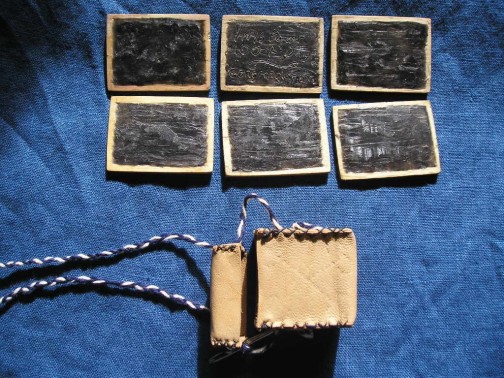O'Connor, Sonia & Dominic Tweddle. 1992. "Set of Waxed Tablets from Swinegate, York" in Bibliologia: 12:107-125.
The article describes in detail the finding of the original tablets, what methods were used to preserve them once they were dug up out of the ground, and a description of the analysis they have undergone since discovery. The tablets were discovered during the excavations in 1989-1990 (p. 309). They were found in the same pit as some 14th Century Pottery, and based on the script used (Cursiva Anglicana) and the letter forms of the Middle English writing on the tablets indicates that they date to the last quarter of the 14th Century (p. 315).
| The original set contained eight tablets. |
Mine contains six tablets. |
| The original tablets are filled with beeswax to which "a copper based pigment or modifier" had been added-the wax is a dark black now (312). |
Mine are filled with beeswax to which I added a bit of store-bought candle wax and some carbon to darken it. |
| The original tablets are made of box wood Buxus sempervirens (p. 310). |
Mine are made of a thin plywood that my step-father had lying around his shop. |
| The original set in the case measures approximately 50mm x 30mm x 15mm. |
Mine were cut based on getting three tablets across on the chunk of plywood, and the finished set in its case measures approximately 50mm x 40mm x 25mm. |
| The original tablets were between 1 and 2 mm thick. |
Mine are between 2 and 3 mm thick. |
| The original case is made of calf leather. |
Mine are made of a random piece of leather from the scrap leather pile. |
| The original case is decorated with a tooled oak leaf pattern. |
I attempted a simple tooled swirl pattern, however my leather is so thin it didn't really show up well. |
| The original case consists of a strip of leather about 40mm high which wrapped around the tablets with stitch holes where the edges met, at a corner of the stack of tablets; the bottom and top of the case did not survive the centuries of burial. |
My case is made with four side seams, with the bottom being contiguous with all four sides. I made the case 37mm tall, and the lid, which has the same construction, 10mm tall. |
| The original thread did not survive, but cellulosic fibres, such as linen or hemp, would not be expected the prevailing acidic burial conditions (p. 313) |
My case was stitched with some surgical suture silk thread I had on hand because it looked like a good weight to use with the leather. |
| The original had a pair of slits on each side, and the leather had stretched between them, creating tunnels |
I used a leather punch to put round holes on the sides to slide the carrying cord through. Over time the cord should deform the leather to make tunnels similar to the original. |
| The original had an iron stylus, which had completely corroded. Based on what remained, it may have been 35mm long and between 2.5 and 3mm in diameter, flattened to a straight edge at one end, and tapering to a point at the other (pg. 31). |
Because I only needed to make two tokens for my two counts, I opted not to make a stylus, but include a large tapestry needle to serve as a writing implement. It works well enough for that purpose, but is not useful for smoothing the wax back out again after the writing is no longer needed. |
| The original had the stylus stored between the last tablet and the case. |
Because I included a needle instead of a stylus, I suspended it from the carrying cord, and store it by sliding it through a hole in the side of the case. The cord should be long enough to make it easy to use the needle to write, and it won't be lost, as it can't fall off of the cord without removing the cord from the case. |
